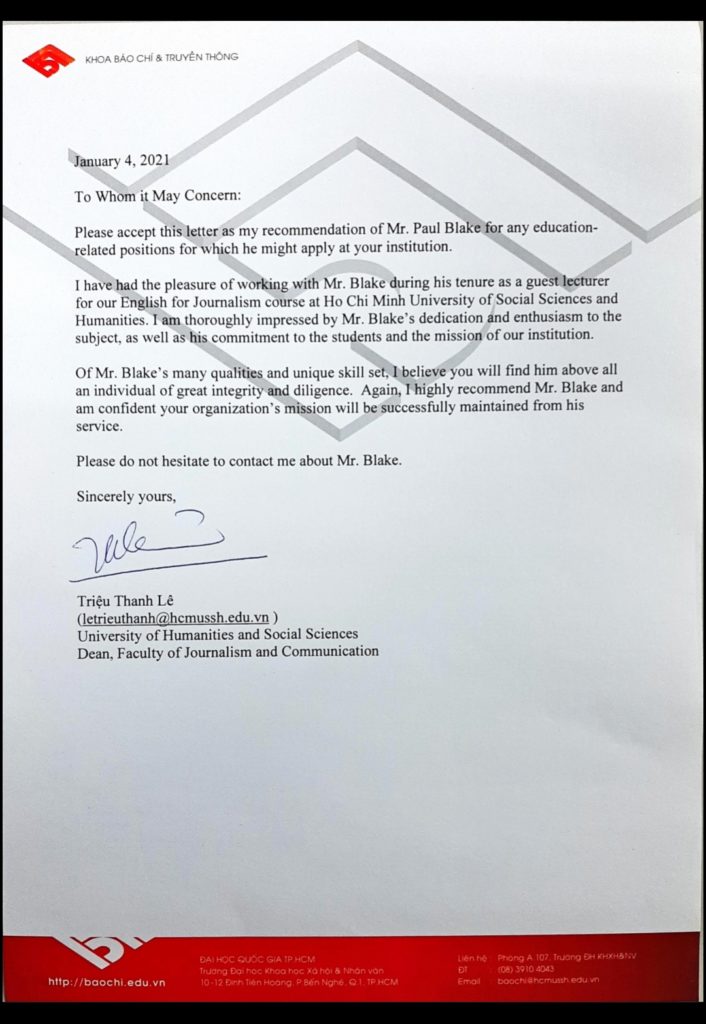University of Social Sciences and Humanities journalism course went online briefly for a week due to Covid-19. A summary of the lessons completed:
Week 1- We summarized local news in a news brief mini-presentation. We talked about the Pentagon Papers as liberation for journalists in America. We created newsgroups, our mission statement, and our motto. We had a two-minute listening practice with Bob Woodward whose guiding principles are “Get Outside Your Comfort Zone • Leave Opinion in the Op-Ed Column • Don’t Take Political Sides”.
Week 2- We talked about the importance of documents, recordings, and sourcing of our information. We covered parts of a page and practiced writing headlines. We talked about how the internet will never replace human sources in investigative journalism. We reviewed some of the tools we use as journalists. We listened to a three-minute clip of Bob Woodward explaining to ask for the documents, develop relationships, and ask your sources for documents.
Week 3- We reviewed the roles in the newsroom and discussed the topics we consider news. We talked about humanizing a story and storytelling larger issues through people. We listened to a three-minute interview with a father and son and answered the comprehension questions about growing up Black in America. We practiced writing our questions and looked at The StoryCorps project and great questions. We brainstormed who we would interview for a personal feature and did a mini-presentation of who and why.
Week 4- We presented our interviews. We looked at the types of headlines and the 5ws. We talked about “On the record vs. off the record”, background vs deep background, should we use anonymous sources, and tips on how to land a big interview or “someone at the top.” We deconstructed a story, types of leads, 5ws, and subheads during a group writing task.
Week 5- We covered misinformation vs. disinformation and the problem with fake news. We talked about clickbait headlines. We talked about confirmation bias and listened to comprehension questions on how we seek information that reinforces our own beliefs. We did a mini-presentation and found a fake news story being spread on our social media profiles. We brainstormed story ideas and discussed commentary/opinion pieces versus hard news/ straight news.
Week 6- We talked about advocacy journalism and did group research on where Gold in Vietnam comes from. We discussed preparing for the interview and each group did a presentation on interview tips. We had listening practice with Katie Couric on ways to prepare for an interview and good interviewer practices. We reviewed the text on quotes and how to attribute them.
Week 7- We defined beat reporting and discussed the different types of beats. We had a listening practice with reporters from Detroit News and The Star Tribune. Each group did a mini-presentation on five tips in covering a beat. We reviewed the deadline checklist and each group selected a topic for their midterm report. Each group presented their story ideas and pretended to pitch a news story to their editor.
Week 8- We discussed how to structure a story. We reviewed the different types of story structures from the text. We deconstructed a story for City Paper and decided which styles were used in the reports on Bey Rutherford. We had listening practice on how to structure a story. Each group presented their story deconstructed with the styles used and comprehension questions answered.
Week 9- We discuss tips from the text on successful feature writing. We learned the different types of features and profiles. Each group found a feature from a news source and presented why they picked this feature, the type of feature it was, and what follow-up questions they would ask. We practiced summarizing a story and brainstormed on Vietnam’s most influential women. We finished with a Beat reporter listening practice on what challenges he has and what his daily tasks look like.
Week 10- We started with a listening practice on how to polish your story. We reviewed ten ethics rules and role-played 5 newsroom scenarios. Each group presented whether or not they would publish the story, what they would do, and which ethics rules applied to their decisions. Each group gave a midterm presentation status update on their stories and was provided an additional week to prepare for the presentation.
Week 11- Marks will be based on each week’s mini-presentation, and attendance and participation. We proceeded in the last-minute online session by reviewing codes of conduct in journalism and listening practice with the core values in journalism. Students individually presented what they thought was the most important core value of journalism and their codes of conduct for their staff if they were the editor of a newspaper. We learned about retractions and what to do if we make a mistake. Our listening practice included what is copyright and Fair Use. Many students presented the four reasons one could claim Fair Use, what we need to do if we use someone else’s work, and an example of it being used in real life.

